Diagenesis, Diagenetic Facies and Their Relationship with Reservoir Sweet Spot in Low-Permeability and Tight Sandstone: Jiaxing Area of the Xihu Sag, East China Sea Basin
Abstract
1. Introduction
2. Geological Setting
3. Materials and Methods
3.1. Petrographic Data
3.2. Quantitative Calculation of Diagenesis Degree
3.3. Petrophysical Analysis
4. Results
4.1. Reservoir Characteristics
4.1.1. Petrographic Characteristics
4.1.2. Sedimentary Characteristics
4.2. Diagenesis and Diagenetic Facies
4.2.1. Diagenesis
- (1)
- Compaction
- (2)
- Cementation
- Silica cementation
- Calcite cementation
- Authigenic clay cementation
- (3)
- Dissolution
4.2.2. Diagenetic Facies
4.3. Logging Evaluation of Diagenetic Facies
4.3.1. Logging Response and Quantitative Discrimination of Diagenetic Facies
4.3.2. Vertical Distribution of Diagenetic Facies
4.4. Vertical Distribution of Reservoir Sweet Spot
5. Discussion
5.1. Control of Sedimentation on Reservoir Sweet Spot
5.1.1. Influence of Sedimentary Microfacies
5.1.2. Influence of Sandstone Grain Size
5.2. Control of Diagenesis on Reservoir Sweet Spot
5.2.1. Influence of Diagenesis
- (1)
- Influence of compaction
- (2)
- Influence of cementation
- (3)
- Influence of dissolution
5.2.2. Influence of Diagenetic Facies
5.3. Distribution Rule of Reservoir Sweet Spot
6. Conclusions
- (1)
- The H3 and H4 sandstones in the Xihu Sag mainly developed compaction, calcite cementation, silica cementation, clay mineral conversion and dissolution. The H3 and H4 sandstones were divided into five diagenetic facies, including dissolution facies, chlorite-coated facies, quartz-cemented facies, calcite-cemented facies and tightly compacted facies. Of these, chlorite-coated facies and dissolution facies are favorable diagenetic facies belts.
- (2)
- The H3 reservoir is mainly composed of chlorite-coated facies, dissolution facies and quartz-cemented facies, whereas the H4 reservoir primarily consists of quartz-cemented facies and chlorite-coated facies. The percentages of type I, type II1 and type II2 sweet spots in the H3 reservoir are approximately 21%, 23% and 26%, respectively, whereas the percentages of type I, type II1 and type II2 sweet spots in the H4 reservoir are about 16%, 15% and 16%, respectively.
- (3)
- The distribution rules of reservoir sweet spots of low-permeability and tight sandstone in H3 and H4 were summarized. Type I reservoir sweet spot occurred in the sedimentary microfacies of the channel bar and the braided channel, and its grain-size lithologies were mainly medium sandstone and coarse sandstone, and the diagenetic facies were chlorite-coated facies and dissolution facies. Type II reservoir sweet spot was primarily developed in the sedimentary microfacies of the braided channel, subaqueous distributary channel and channel bar, and its lithologies were medium sandstone, fine sandstone and sandy conglomerate, and the diagenetic facies were quartz-cemented facies, chlorite-coated facies and dissolution facies. Type III reservoir sweet spot was located in the sedimentary microfacies of the subaqueous distributary channel, and its lithologies were fine sandstone, siltstone and medium sandstone, and the diagenetic facies were tightly compacted facies, calcite-cemented facies and quartz-cemented facies.
Author Contributions
Funding
Data Availability Statement
Conflicts of Interest
References
- Salem, A.M.; Ketzer, J.; Morad, S.; Rizk, R.R.; Al-Aasm, I. Diagenesis and Reservoir-Quality Evolution of Incised-Valley Sandstones: Evidence from the Abu Madi Gas Reservoirs (Upper Miocene), the Nile Delta Basin, Egypt. J. Sediment. Res. 2005, 75, 572–584. [Google Scholar] [CrossRef]
- McKinley, J.M.; Atkinson, P.; Lloyd, C.; Ruffell, A.H.; Worden, R.H. How Porosity and Permeability Vary Spatially with Grain Size, Sorting, Cement Volume, and Mineral Dissolution In Fluvial Triassic Sandstones: The Value of Geostatistics and Local Regression. J. Sediment. Res. 2011, 81, 844–858. [Google Scholar] [CrossRef]
- Dar, Q.U.Z.; Pu, R.; Baiyegunhi, C.; Shabeer, G.; Ali, R.I.; Ashraf, U.; Sajid, Z.; Mehmood, M. The impact of diagenesis on the reservoir quality of the early Cretaceous Lower Goru sandstones in the Lower Indus Basin, Pakistan. J. Pet. Explor. Prod. Technol. 2021, 12, 1437–1452. [Google Scholar] [CrossRef]
- Taylor, T.R.; Giles, M.R.; Hathon, L.A.; Diggs, T.N.; Braunsdorf, N.R.; Birbiglia, G.V.; Kittridge, M.G.; Macaulay, C.I.; Espejo, I.S. Sandstone diagenesis and reservoir quality prediction: Models, myths, and reality. AAPG Bull. 2010, 94, 1093–1132. [Google Scholar] [CrossRef]
- Wang, E.Z.; Liu, G.Y.; Pang, X.Q.; Wu, Z.Y.; Li, C.R.; Bai, H.; Zhang, Z.H. Sedimentology, diagenetic evolution, and sweet spot prediction of tight sandstone reservoirs: A case study of the third member of the Upper Paleogene Shahejie Formation, Nanpu, Bohai Bay Basin, China. J. Pet. Sci. Eng. 2020, 186, 106718. [Google Scholar] [CrossRef]
- Bjorlykke, K.; Jahren, J. Open or closed geochemical systems during diagenesis in sedimentary basins: Constraints on mass transfer during diagenesis and the prediction of porosity in sandstone and carbonate reservoirs. AAPG Bull. 2012, 96, 2193–2214. [Google Scholar] [CrossRef]
- Kassab, M.A.; Hassanain, I.M.; Salem, A.M. Petrography, diagenesis and reservoir characteristics of the Pre-Cenomanian sandstone, Sheikh Attia area, East Central Sinai, Egypt. J. Afr. Earth Sci. 2014, 96, 122–138. [Google Scholar] [CrossRef]
- Makeen, Y.M.; Abdullah, W.H.; Ayinla, H.A.; Hakimi, M.H.; Sia, S.-G. Sedimentology, diagenesis and reservoir quality of the upper Abu Gabra Formation sandstones in the Fula Sub-basin, Muglad Basin, Sudan. Mar. Pet. Geol. 2016, 77, 1227–1242. [Google Scholar] [CrossRef]
- Yuan, G.H.; Cao, Y.C.; Gluyas, J.; Cao, X.; Zhang, W.B. Petrography, fluid-inclusion, isotope, and trace- element constraints on the origin of quartz cementation and feldspar dissolution and the associated fluid evolution in arkosic sandstones. AAPG Bull. 2018, 102, 761–792. [Google Scholar] [CrossRef]
- Qiu, Z.; Zou, C. Controlling factors on the formation and distribution of “sweet-spot areas” of marine gas shales in South China and a preliminary discussion on unconventional petroleum sedimentology. J. Asian Earth Sci. 2019, 194, 103989. [Google Scholar] [CrossRef]
- Cui, Y.F.; Wang, G.W.; Jones, S.J.; Zhou, Z.L.; Ran, Y.; Lai, J.; Li, R.J.; Deng, L. Prediction of diagenetic facies using well logs—A case study from the upper Triassic Yanchang Formation, Ordos Basin, China. Mar. Pet. Geol. 2017, 81, 50–65. [Google Scholar] [CrossRef]
- Mansurbeg, H.; Morad, S.; Salem, A.; Marfil, R.; El-Ghali, M.; Nystuen, J.; Caja, M.; Amorosi, A.; Garcia, D.; La Iglesia, A. Diagenesis and reservoir quality evolution of palaeocene deep-water, marine sandstones, the Shetland-Faroes Basin, British continental shelf. Mar. Pet. Geol. 2008, 25, 514–543. [Google Scholar] [CrossRef]
- Nguyen, B.T.T.; Jones, S.; Goulty, N.R.; Middleton, A.J.; Grant, N.; Ferguson, A.; Bowen, L. The role of fluid pressure and diagenetic cements for porosity preservation in Triassic fluvial reservoirs of the Central Graben, North Sea. AAPG Bull. 2013, 97, 1273–1302. [Google Scholar] [CrossRef]
- Wu, D.; Liu, S.; Chen, H.; Lin, L.; Yu, Y.; Xu, C.; Pan, B. Investigation and prediction of diagenetic facies using well logs in tight gas reservoirs: Evidences from the Xu-2 member in the Xinchang structural belt of the western Sichuan Basin, western China. J. Pet. Sci. Eng. 2020, 192, 107326. [Google Scholar] [CrossRef]
- Ozkan, A.; Cumella, S.P.; Milliken, K.L.; Laubach, S.E. Prediction of lithofacies and reservoir quality using well logs, Late Cretaceous Williams Fork Formation, Mamm Creek field, Piceance Basin, Colorado. AAPG Bull. 2011, 95, 1699–1723. [Google Scholar] [CrossRef]
- Lai, J.; Wang, G.; Wang, S.; Cao, J.; Li, M.; Pang, X.; Zhou, Z.; Fan, X.; Dai, Q.; Yang, L.; et al. Review of diagenetic facies in tight sandstones: Diagenesis, diagenetic minerals, and prediction via well logs. Earth-Sci. Rev. 2018, 185, 234–258. [Google Scholar] [CrossRef]
- Zeng, H.; Zhu, X.; Zhu, R.; Zhang, Q. Seismic prediction of sandstone diagenetic facies: Applied to Cretaceous Qingshankou Formation in Qijia Depression, Songliao Basin, East China. Pet. Explor. Dev. 2013, 40, 287–2954. [Google Scholar] [CrossRef]
- Anees, A.; Zhang, H.; Ashraf, U.; Wang, R.; Thanh, H.V.; Radwan, A.E.; Ullah, J.; Abbasi, G.R.; Iqbal, I.; Ali, N.; et al. Sand-ratio distribution in an unconventional tight sandstone reservoir of Hangjinqi area, Ordos Basin: Acoustic impedance inversion-based reservoir quality prediction. Front. Earth Sci. 2022, 10. [Google Scholar] [CrossRef]
- Ashraf, U.; Anees, A.; Shi, W.Z.; Wang, R.; Ali, M.; Jiang, R.; Thanh, H.V.; Iqbal, I.; Zhang, X.N.; Zhang, H.C. Estimation of porosity and facies distribution through seismic inversion in an unconventional tight sandstone reservoir of Hangjinqi area, Ordos basin. Front. Earth Sci. 2022, 10, 1014052. [Google Scholar] [CrossRef]
- Zou, C.N.; Tao, S.Z.; Zhou, H.; Zhang, X.-X.; He, D.-B.; Zhou, C.-M.; Wang, L.; Wang, X.S.; Li, F.-H.; Zhu, R.-K.; et al. Genesis, classification, and evaluation method of diagenetic facies. Pet. Explor. Dev. 2008, 35, 526–540. [Google Scholar] [CrossRef]
- Sun, L.D.; Zhao, W.Z.; Liu, H.; Zhu, R.K.; Bai, B.; Kang, Y.; Zhang, J.Y.; Wu, S.T. Concept and application of “sweet spot” in shale oil. Acta Pet. Sin. 2023, 44, 1–13. [Google Scholar]
- Zhang, S.; Liu, H.; Liu, Y.; Wang, Y.; Wang, M.; Bao, Y.; Hu, Q.; Li, Z.; Zhang, S.; Yao, S.; et al. Main controls and geological sweet spot types in Paleogene shale oil rich areas of the Jiyang Depression, Bohai Bay basin, China. Mar. Pet. Geol. 2019, 111, 576–587. [Google Scholar] [CrossRef]
- Popov, M.A.; Nuccio, V.F.; Dyman, T.S.; Gognat, T.A.; Johnson, R.C.; Schmoker, J.W.; Wilson, M.S.; Bartberger, C. Basin-Centered Gas Systems of the U.S. USGS; U.S. Geological Survey: Reston, VA, USA, 2000; pp. 5–299.
- Law, B.E. Basin-centered gas systems. AAPG Bull. 2002, 86, 1891–1919. [Google Scholar]
- Yang, S.Y.; Zhang, J.C.; Huang, W.D.; Zhang, Y.; Tang, X. “Sweet spot” types of reservoirs and genesis of tight sandstone gas in Kekeya area, Turpan-Hami Basin. Acta Pet. Sin. 2013, 34, 272–282. [Google Scholar]
- Lai, J.; Wang, G.; Ran, Y.; Zhou, Z.; Cui, Y. Impact of diagenesis on the reservoir quality of tight oil sandstones: The case of Upper Triassic Yanchang Formation Chang 7 oil layers in Ordos Basin, China. J. Pet. Sci. Eng. 2016, 145, 54–65. [Google Scholar] [CrossRef]
- Morad, S.; Al-Ramadan, K.; Ketzer, J.M.; De Ros, L.F. The impact of diagenesis on the heterogeneity of sandstone reservoirs: A review of the role of depositional facies and sequence stratigraphy. AAPG Bull. 2010, 94, 1267–1309. [Google Scholar] [CrossRef]
- Wang, W.G.; Lin, C.Y.; Zhang, X.G.; Dong, C.M.; Ren, L.H.; Lin, J.L. Effect of burial history on diagenetic and reservoir-forming process of the Oligocene sandstones in Xihu sag, East China Sea Basin. Mar. Pet. Geol. 2019, 112, 104034. [Google Scholar] [CrossRef]
- Lou, M.; Cai, H.; He, X.; Liu, Y.; Huang, X.; Zhang, X.; Liu, H. Application of seismic sedimentology in characterization of fluvial-deltaic reservoirs in Xihu sag, East China Sea shelf basin. Pet. Explor. Dev. 2023, 50, 138–151. [Google Scholar] [CrossRef]
- Ye, J.; Qing, H.; Bend, S.L.; Gu, H. Petroleum systems in the offshore Xihu Basin on the continental shelf of the East China Sea. AAPG Bull. 2007, 91, 1167–1188. [Google Scholar] [CrossRef]
- Folk, R.L.; Andrews, P.B.; Lewis, D.W. Detrital sedimentary rock classification and nomenclature for use in New Zealand. New Zealand J. Geol. Geophys. 1970, 13, 937–968. [Google Scholar] [CrossRef]
- Wang, W.; Lin, C.; Zhang, X.; Dong, C.; Ren, L.; Lin, J. Provenance, clastic composition and their impact on diagenesis: A case study of the Oligocene sandstone in the Xihu sag, East China Sea Basin. Mar. Pet. Geol. 2020, 126, 104890. [Google Scholar] [CrossRef]
- Abbas, A.; Zhu, H.; Zeng, Z.; Zhou, X. Sedimentary facies analysis using sequence stratigraphy and seismic sedimentology in the Paleogene Pinghu Formation, Xihu Depression, East China Sea Shelf Basin. Mar. Pet. Geol. 2018, 93, 287–297. [Google Scholar] [CrossRef]
- Kashihara, K.; Tsuji, T. Improvement in facies discrimination using multipleseismic attributes for permeability modelling of the Athabasca Oil Sands, Canada. Explor. Geophys. 2010, 41, 80–87. [Google Scholar] [CrossRef]
- Zou, C.N.; Li, X.J.; Zhu, R.K.; Wan, J.Y.; Li, J.Z.; Hu, Y.; Shi, L.; Hui, K.Y. SY/T 6832-2011 Geological Evaluating Methods for Tight Sandstone Gas; Petroleum Industry Press: Beijing, China, 2011; pp. 1–5. [Google Scholar]

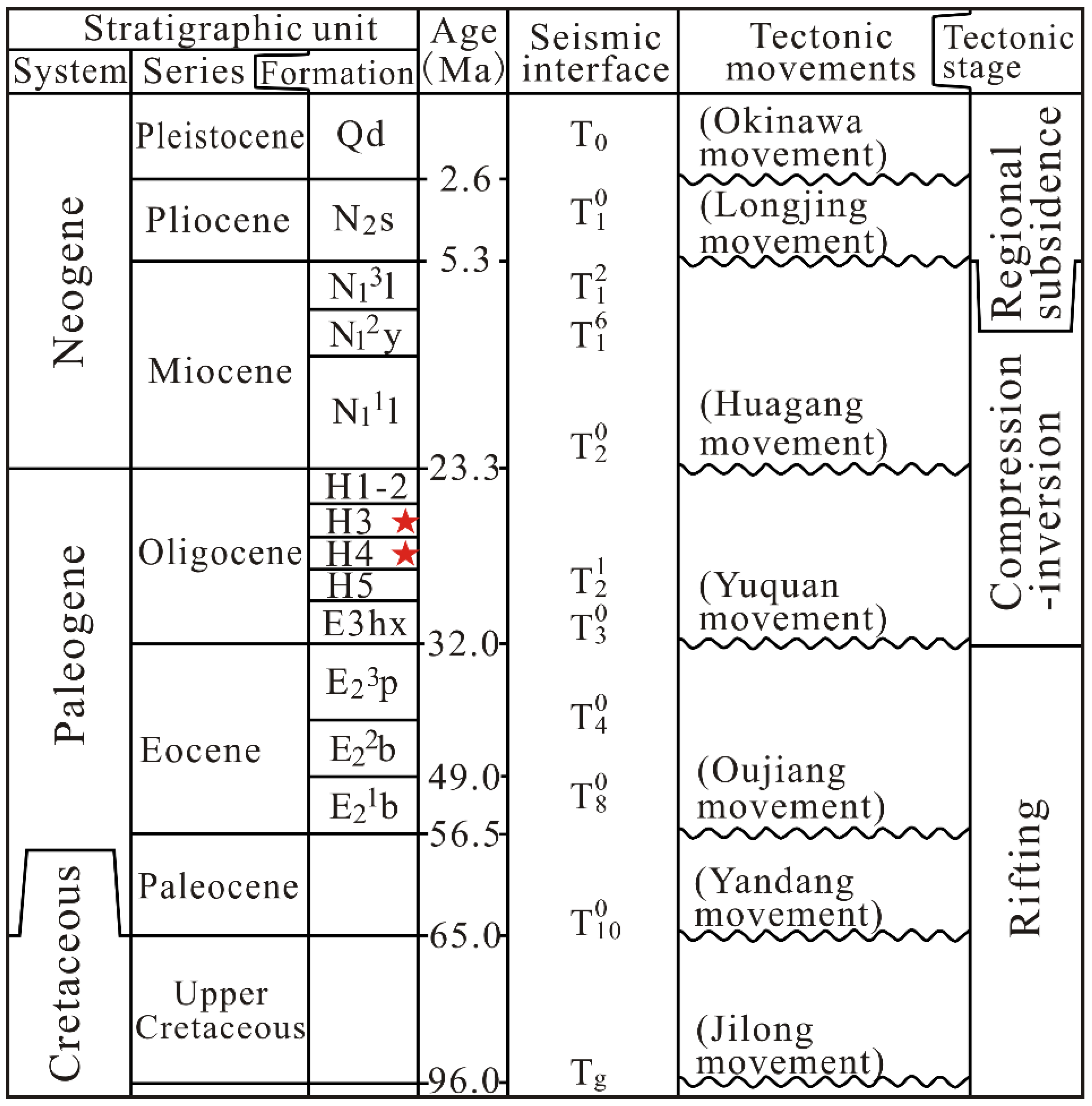

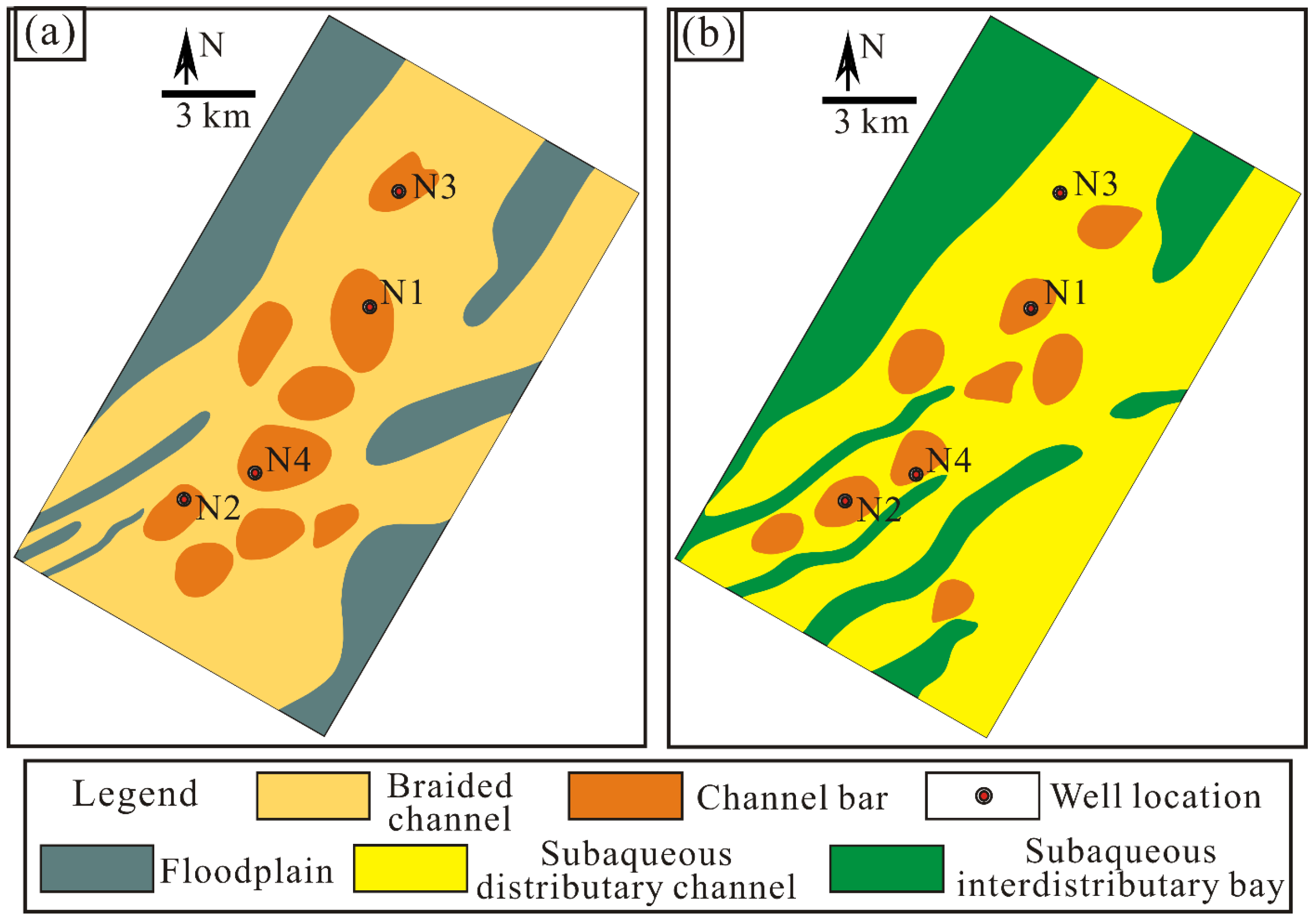
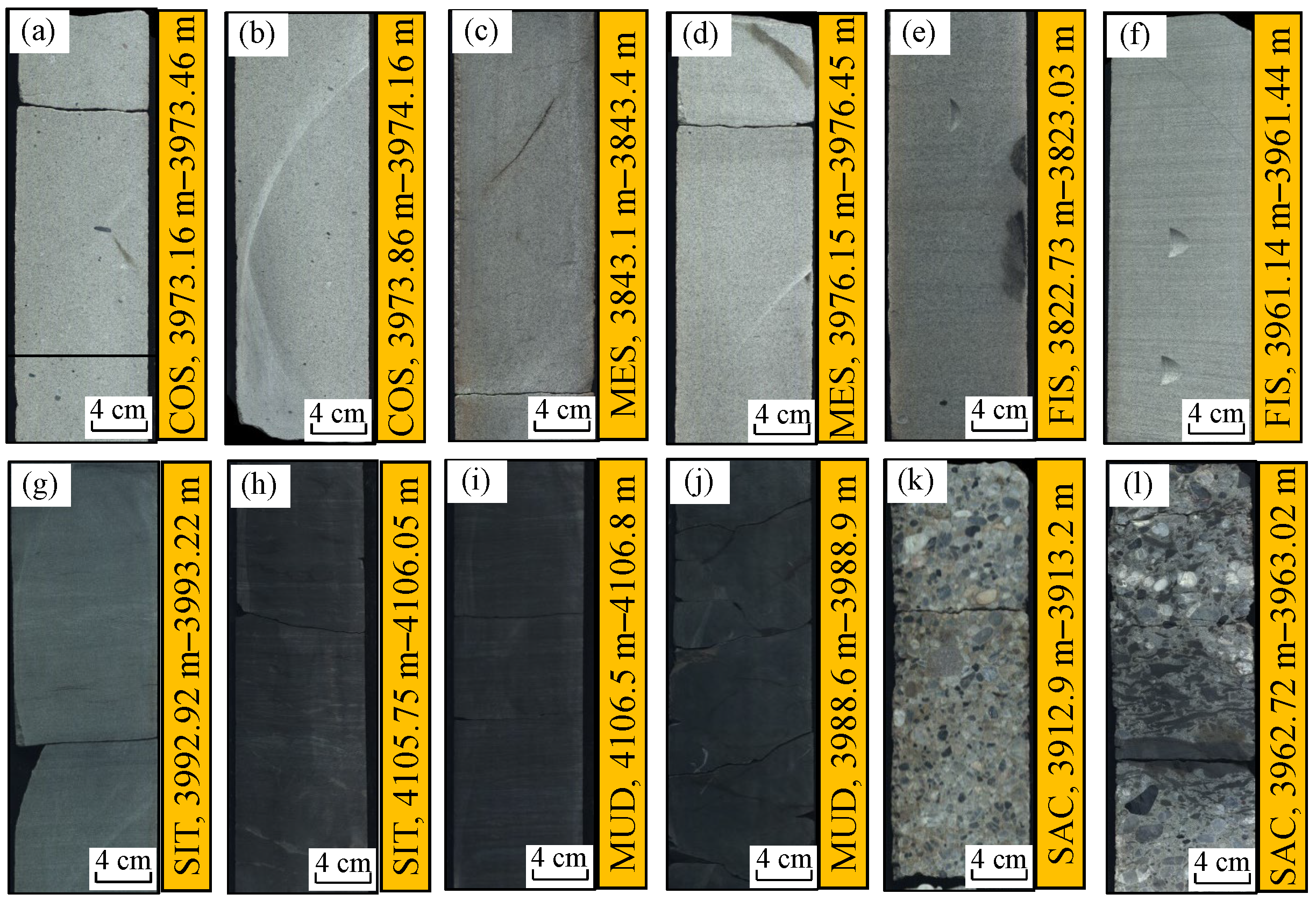


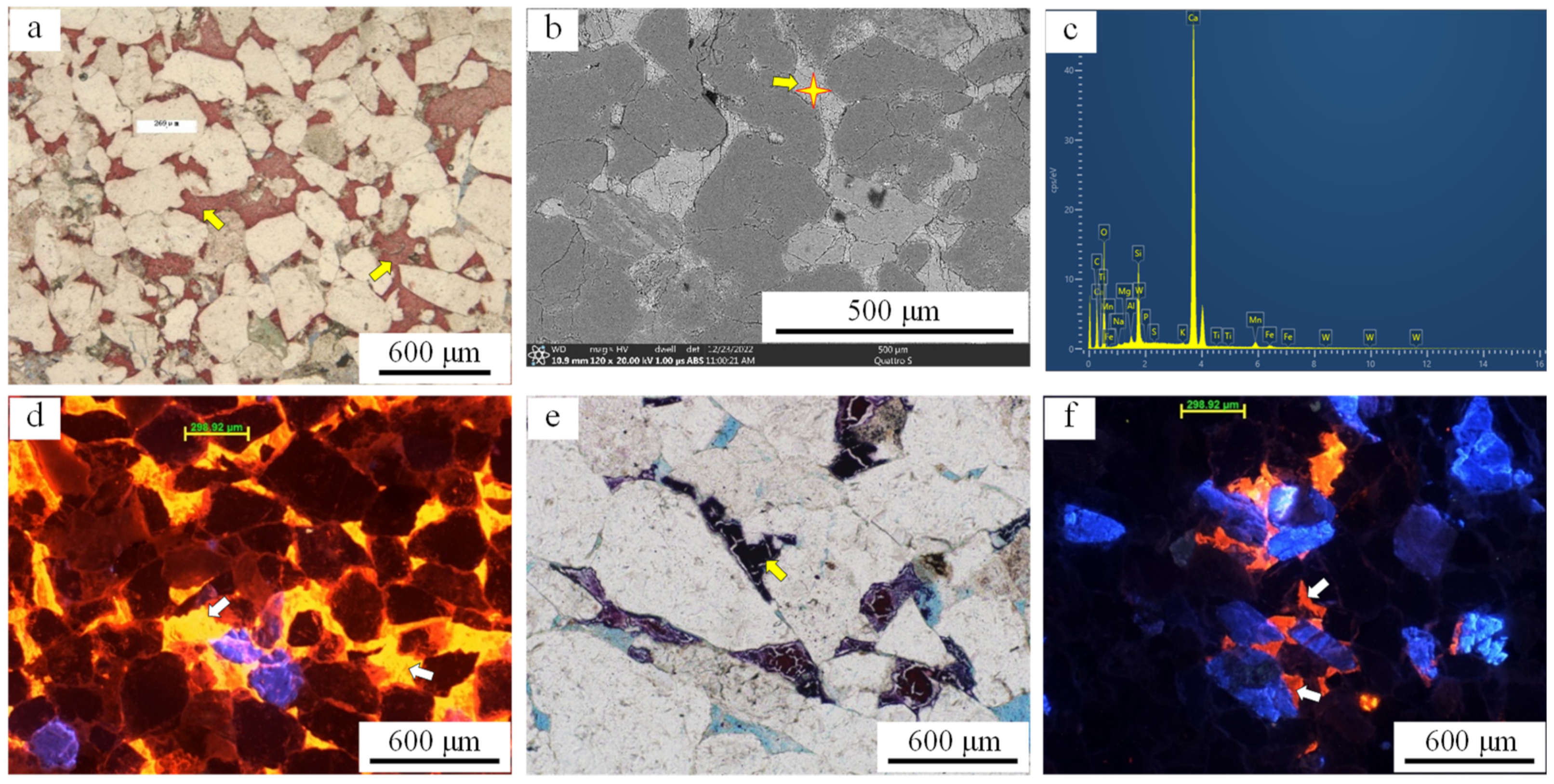
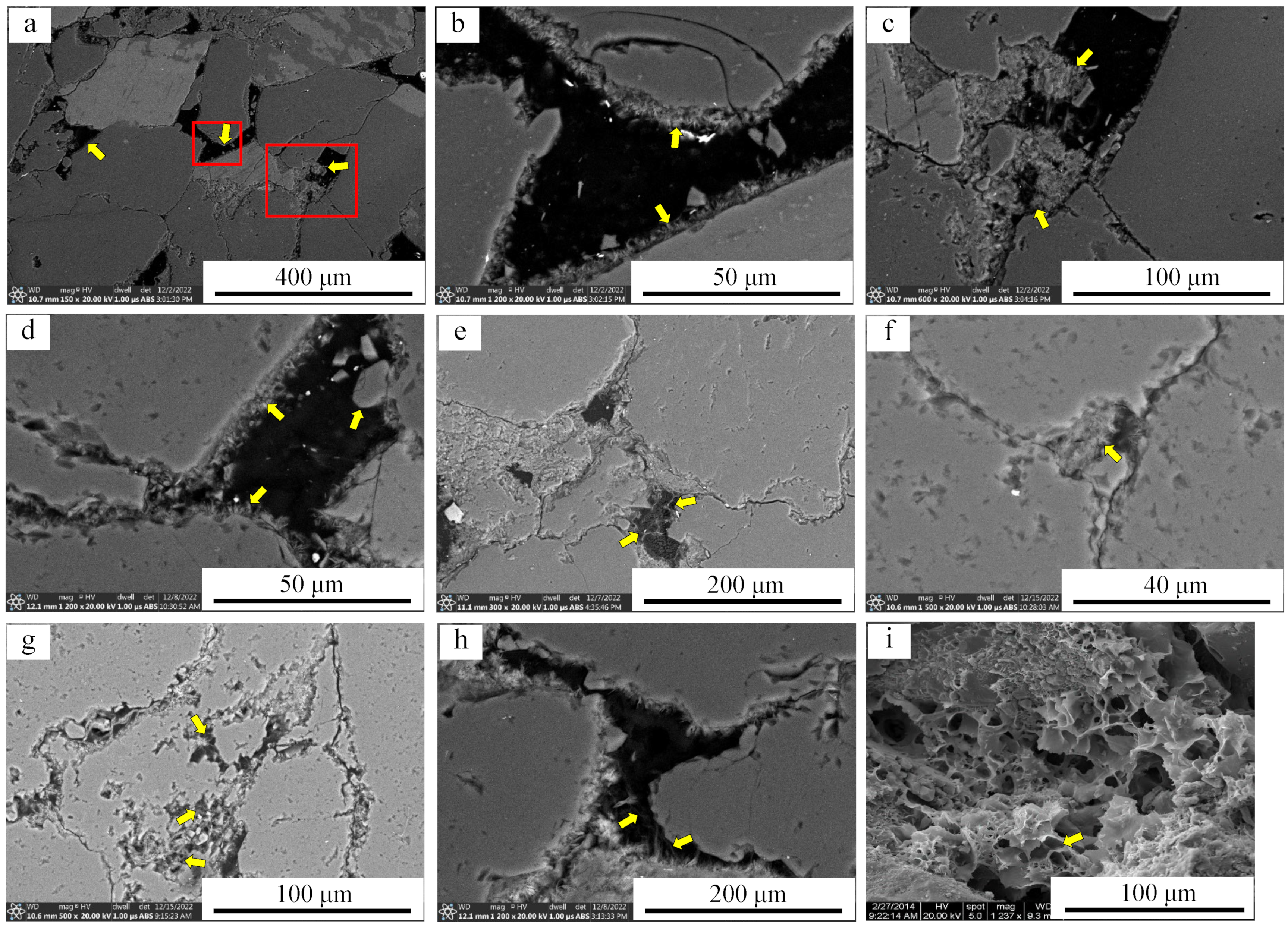
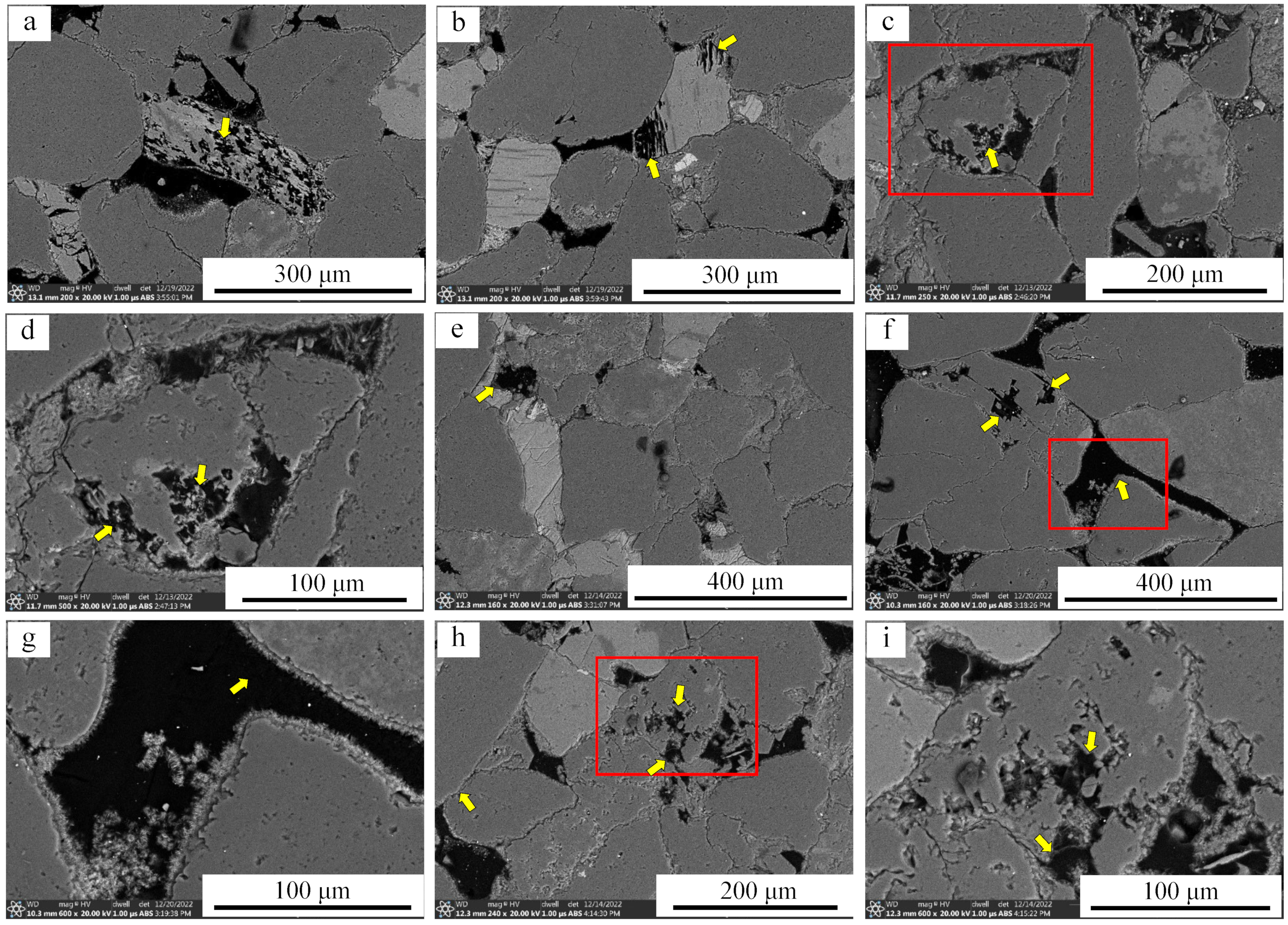

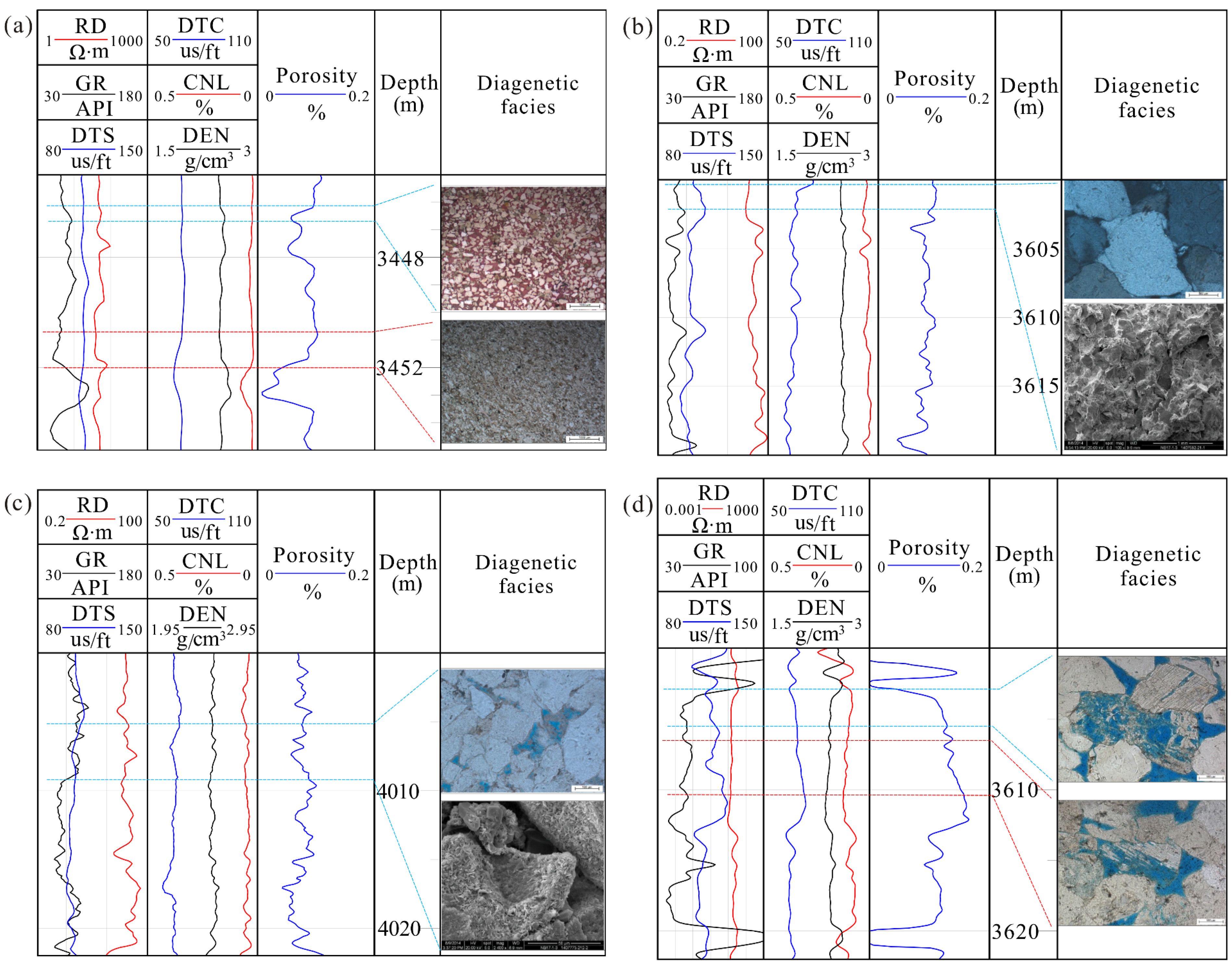


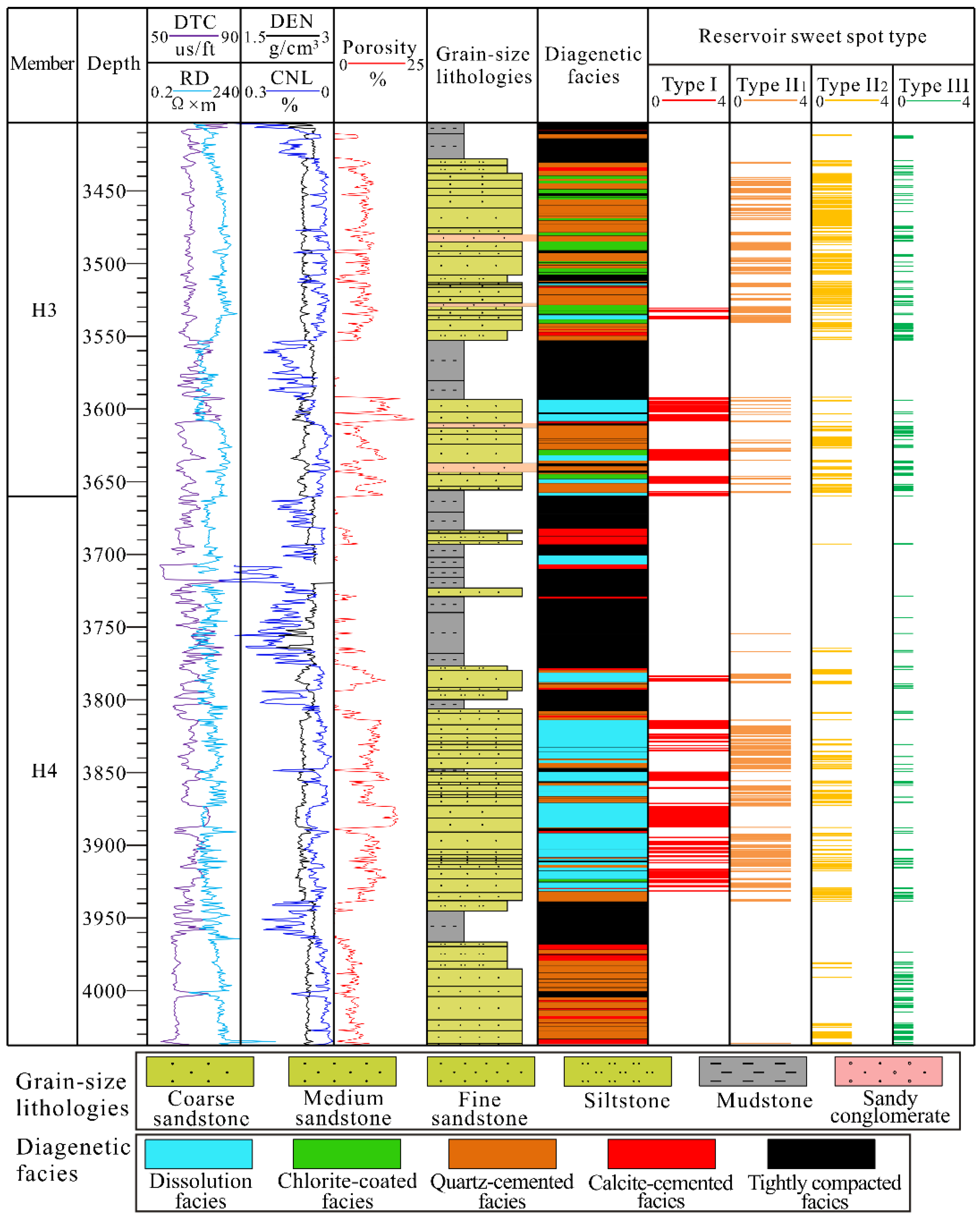
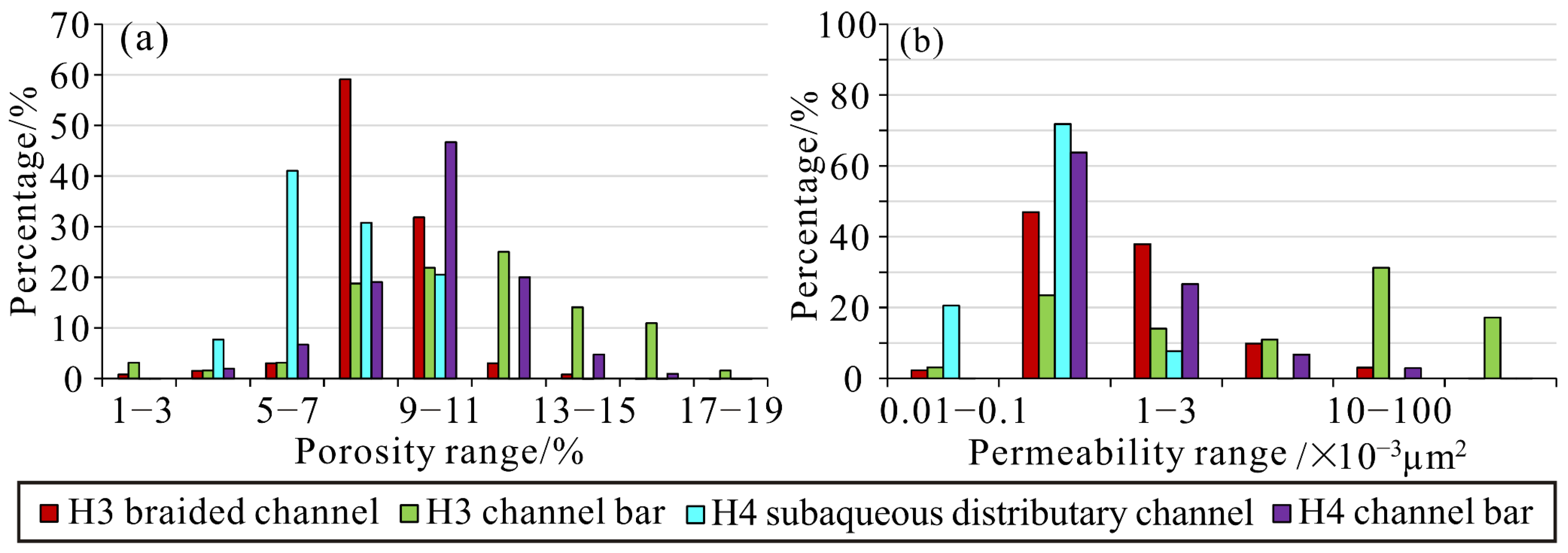

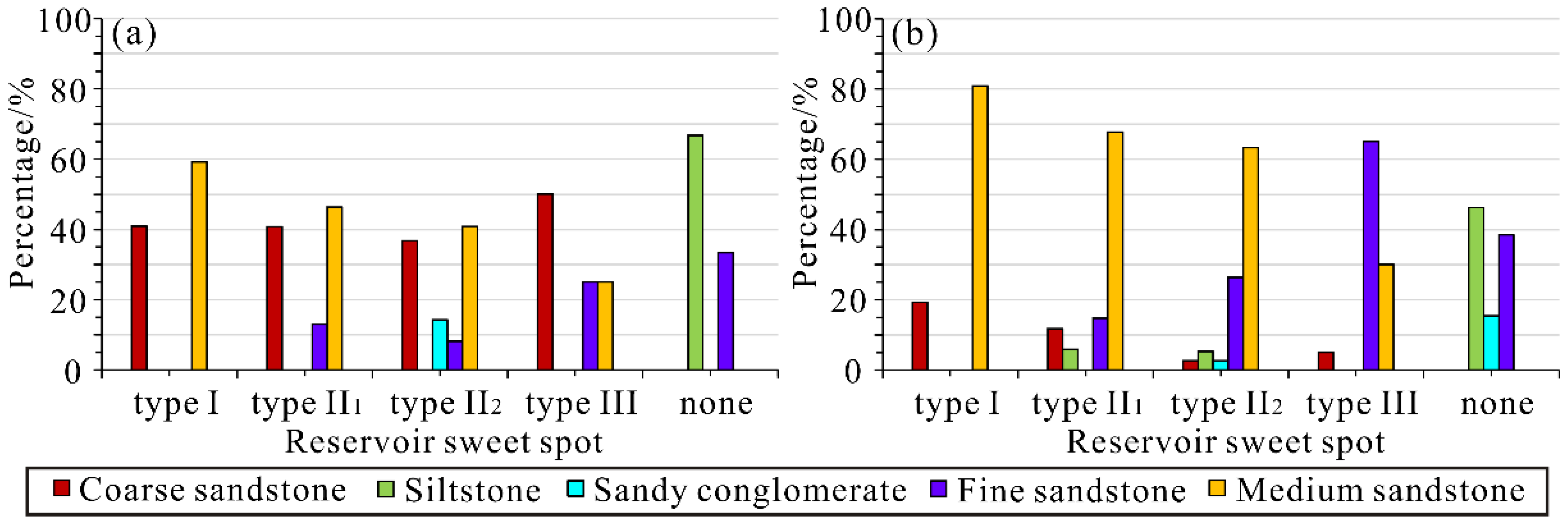
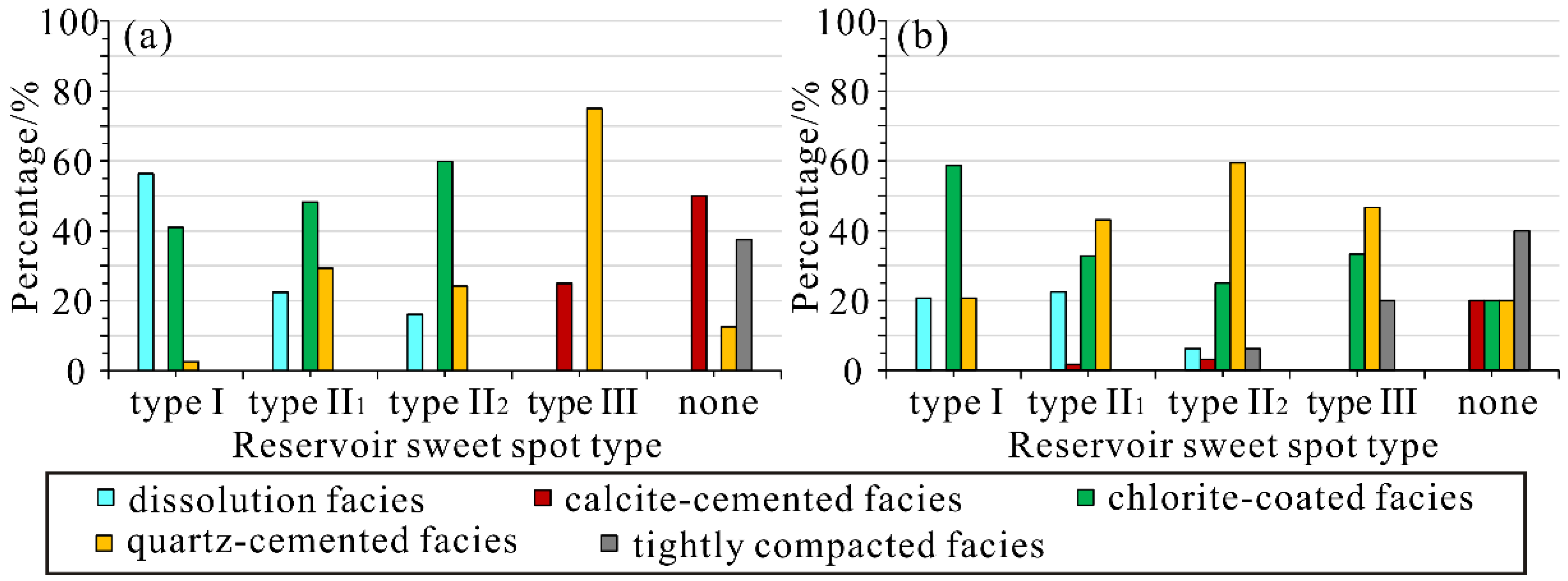
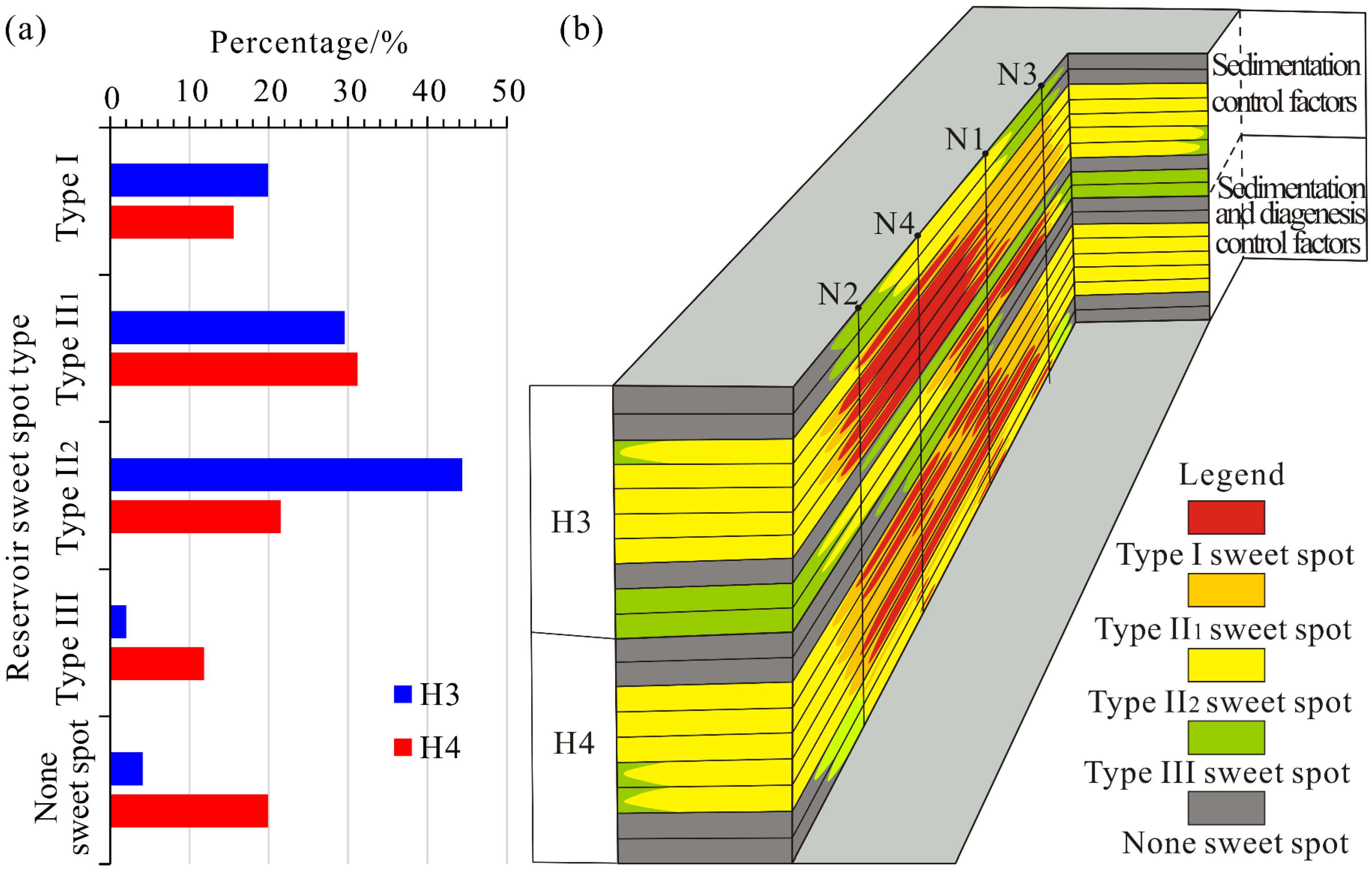
| Diagenetic Facies | Dissolution Facies | Chlorite-Coated Facies | Quartz-Cemented Facies | Calcite-Cemented Facies | Tightly Compacted Facies | |
|---|---|---|---|---|---|---|
| Primary porosity/% | 35.81 | 34.81 | 34.41 | 33.15 | 35.44 | |
| Porosity/% | 10.99 | 9.72 | 8.5 | 5.34 | 6.43 | |
| Permeability/10−3 μm2 | 25.8 | 7.31 | 0.79 | 0.42 | 0.11 | |
| Quartz/% | 63.39 | 64.48 | 65 | 64.78 | 65.61 | |
| K-feldspar/% | 7.02 | 7.03 | 7 | 6.56 | 6.89 | |
| Plagioclase/% | 9.2 | 9.22 | 9.52 | 8.44 | 9.56 | |
| Feldspar/% | 16.22 | 16.25 | 16.52 | 15 | 16.44 | |
| Volcanic rock fragment/% | 8.54 | 8.27 | 7.64 | 9.28 | 7.28 | |
| Metamorphic rock fragment/% | 9.15 | 8.75 | 8.63 | 9.06 | 8.06 | |
| Sedimentary rock fragment/% | 2.71 | 2.25 | 2.21 | 1.89 | 2.61 | |
| Total rock fragment/% | 20.39 | 19.27 | 18.53 | 20.22 | 17.94 | |
| Argillaceous matrix/% | 1.88 | 2.72 | 4.23 | 1 | 9.61 | |
| Calcite cement/% | 1 | 1.28 | 1.56 | 21 | 6.18 | |
| Silica cement/% | 0.7 | 0.84 | 0.75 | 0.42 | 0.39 | |
| Clay mineral/% | 4.36 | 5.01 | 7.17 | 5.9 | 11.13 | |
| Illite-smectite mixed-layer/% | 0.84 | 1.23 | 1.94 | 1.74 | 4.06 | |
| Illite/% | 1.1 | 1.22 | 2.35 | 1.68 | 4.28 | |
| Kaolinite/% | 0.27 | 0.27 | 0.31 | 0.25 | 0.41 | |
| Chlorite/% | 2.15 | 2.29 | 2.57 | 2.23 | 2.38 | |
| Sorting | Good | 42.42 | 58.16 | 61.25 | 28.57 | 61.11 |
| Good-medium | 45.45 | 14.29 | 25 | 57.14 | 22.22 | |
| Medium | 9.09 | 24.49 | 8.75 | 14.29 | 0 | |
| Medium-poor | 3.03 | 3.06 | 5 | 0 | 16.67 | |
| Roundness | Subcircular | 0 | 2.04 | 0 | 0 | 0 |
| Subangular- subcircular | 100 | 88.78 | 62.5 | 85.71 | 22.22 | |
| Subcircular- subangular | 0 | 9.18 | 37.5 | 14.29 | 72.22 | |
| Subangular | 0 | 0 | 0 | 0 | 5.56 | |
| Contact type | Concave-convex to line | 12.12 | 20.41 | 27.5 | 0 | 0 |
| Line | 27.27 | 18.37 | 27.5 | 0 | 16.67 | |
| Line to point | 60.61 | 61.22 | 42.5 | 57.14 | 66.67 | |
| point | 0 | 0 | 2.5 | 42.86 | 16.67 | |
| Grain size | Coarse sandstone | 25 | 10.22 | 8.65 | 0 | 0 |
| Sandy conglomerate | 1.04 | 9.68 | 4.32 | 27.27 | 10.53 | |
| Fine sandstone | 11.46 | 11.29 | 45.41 | 27.27 | 42.11 | |
| Medium sandstone | 62.5 | 68.82 | 41.62 | 36.36 | 0 | |
| Silstone | 0 | 0 | 0 | 9.09 | 47.37 | |
| Surface porosity/% | 4.91 | 4.71 | 2.37 | 3.61 | 1.42 | |
| Primary intergranular pore/% | 1.03 | 0.82 | 0.3 | 0.32 | 0.09 | |
| Intergranular dissolved pore/% | 2.01 | 2.04 | 1 | 1.35 | 0.59 | |
| Moldic pore/% | 1.03 | 0.86 | 0.58 | 0.64 | 0.28 | |
| Intergranular dissolved pore/% | 0.83 | 0.98 | 0.52 | 1.3 | 0.46 | |
| Secondary porosity/% | 6.29 | 5.53 | 5.28 | 4.12 | 4.35 | |
| Primary porosity/% | 4.7 | 4.19 | 3.23 | 1.22 | 2.08 | |
| Compactional porosity loss rate/% | 73.91 | 74.91 | 76 | 31.45 | 78.04 | |
| Cementation porosity loss rate/% | 8.89 | 12.02 | 15.17 | 64.86 | 16.14 | |
| Dissolution porosity enhancement rate/% | 17.25 | 16.29 | 14.01 | 12.41 | 12.58 | |
| Diagenetic Facies | Dissolution Facies | Chlorite-Coated Facies | Quartz-Cemented Facies | Calcite-Cemented Facies | Tightly Compacted Facies | |||||
|---|---|---|---|---|---|---|---|---|---|---|
| Range | Average | Range | Average | Range | Average | Range | Average | Range | Average | |
| CNL/% | 0.02–0.13 | 0.05 | 0.02–0.12 | 0.05 | 0–0.11 | 0.04 | 0–0.09 | 0.04 | 0.03–0.15 | 0.08 |
| DTC/μs/ft | 63.65–73.73 | 68.61 | 59.39–71.18 | 67.58 | 60.85–70.22 | 65.9 | 60.63–68.33 | 63.74 | 58.59–70.16 | 64.57 |
| DTS/μs/ft | 100.91–125.8 | 110.43 | 100.02–114.63 | 108.72 | 95.61–113.79 | 105.5 | 93.28–113.51 | 103.44 | 98.81–124.88 | 107.68 |
| GR/API | 38.2–84.7 | 61.13 | 35.87–93.7 | 60.67 | 40.1–105.7 | 68.5 | 38.98–85.27 | 62.35 | 65.59–146.91 | 100.08 |
| DEN/g/cm3 | 2.37–2.55 | 2.47 | 2.37–2.57 | 2.49 | 2.39–2.69 | 2.53 | 2.51–2.64 | 2.57 | 2.55–2.68 | 2.61 |
| RT/Ω·m | 7.63–54.79 | 26.01 | 11.12–94.19 | 35.32 | 13.71–141.02 | 44.05 | 19.88–118.03 | 52.47 | 18.36–61.12 | 39.89 |
| PHIE/% | 0.07–0.16 | 0.11 | 0.06–0.14 | 0.1 | 0–0.12 | 0.08 | 0.02–0.09 | 0.06 | 0–0.07 | 0.03 |
| Member | Diagenetic Facies | Sample Size | Primary Porosity/% | Intergranular Volume/% | Compactional Porosity Loss Rate/% | ||
|---|---|---|---|---|---|---|---|
| Range | Average | Range | Average | ||||
| H3 | Dissolution facies | 32 | 35.81 | 6.34–14.89 | 11.2 | 61.2–82.3 | 72.73 |
| Calcite-cemented facies | 2 | 33.15 | 30–30.24 | 30.12 | 8.79–9.5 | 9.15 | |
| Chlorite-coated facies | 54 | 34.81 | 5.45–20.48 | 9.99 | 46.9–84.36 | 74.8 | |
| Quartz-cemented facies | 20 | 34.41 | 5.35–34.78 | 10.65 | 42.52–84.45 | 76.03 | |
| H4 | Dissolution facies | 6 | 35.81 | 5.94–18.99 | 10.31 | 60.93–83.41 | 76.8 |
| Calcite-cemented facies | 3 | 33.15 | 11.2–27.32 | 20.13 | 20.61–81.3 | 46.32 | |
| Chlorite-coated facies | 73 | 34.81 | 3.94–20.27 | 11.39 | 44.64–88.69 | 74.99 | |
| Quartz-cemented facies | 63 | 34.41 | 2.91–25.95 | 11.64 | 41.57–91.55 | 75.99 | |
| Tightly compacted facies | 5 | 35.44 | 8.98–14.54 | 11.98 | 74.85–82.3 | 78.04 | |
| Member | Diagenetic Facies | Sample Size | Primary Porosity/% | Cement Volume/% | Cementation Porosity Loss Rate/% | ||
|---|---|---|---|---|---|---|---|
| Range | Average | Range | Average | ||||
| H3 | Dissolution facies | 32 | 35.81 | 0.5–8 | 3.17 | 1.4–22.34 | 8.84 |
| Calcite-cemented facies | 2 | 33.15 | 30–30 | 30 | 90.5–90.5 | 90.5 | |
| Chlorite-coated facies | 54 | 34.81 | 0.5–14 | 3.47 | 1.44–40.22 | 9.96 | |
| Quartz-cemented facies | 20 | 34.41 | 1–15.3 | 3.82 | 2.91–44.46 | 11.09 | |
| H4 | Dissolution facies | 6 | 35.81 | 1–6 | 3.75 | 2.79–16.76 | 10.47 |
| Calcite-cemented facies | 3 | 33.15 | 5.5–24 | 15.83 | 16.59–72.4 | 47.76 | |
| Chlorite-coated facies | 73 | 34.81 | 0.5–15.5 | 4.72 | 1.44–44.53 | 13.55 | |
| Quartz-cemented facies | 63 | 34.41 | 0.5–18 | 5.67 | 1.45–52.31 | 16.47 | |
| Tightly compacted facies | 5 | 35.44 | 4.3–7 | 5.72 | 12.13–19.75 | 16.14 | |
| Member | Diagenetic Facies | Sample Size | Surface Porosity/% | Secondary Pore/% | Dissolution Porosity Enhancement Rate/% | |||
|---|---|---|---|---|---|---|---|---|
| Range | Average | Range | Average | Range | Average | |||
| H3 | Dissolution facies | 32 | 1.83–19.52 | 8.1 | 0.92–9.57 | 3.9 | 13.3–24.04 | 17.36 |
| Calcite-cemented facies | 2 | 0.66–0.91 | 0.79 | 0.62–0.91 | 0.76 | 7.54–10.45 | 9 | |
| Chlorite-coated facies | 54 | 0.2–11.37 | 5.35 | 0.11–5.59 | 2.67 | 11.5–21.64 | 15.09 | |
| Quartz-cemented facies | 20 | 0.15–8.6 | 3.12 | 0.03–4.82 | 1.65 | 5.21–19.09 | 13.23 | |
| H4 | Dissolution facies | 6 | 2.23–9.68 | 4.77 | 1.5–3.54 | 2.55 | 12.87–20.42 | 16.96 |
| Calcite-cemented facies | 3 | 3.01–9.35 | 5.5 | 2.17–5.72 | 3.63 | 3.32–22.7 | 14.69 | |
| Chlorite-coated facies | 73 | 0.72–12.03 | 5.66 | 0.38–7.31 | 3.39 | 8.78–28.03 | 17.17 | |
| Quartz-cemented facies | 63 | 0.2–6.65 | 2.11 | 0.13–5.11 | 1.38 | 8.8–23.34 | 14.25 | |
| Tightly compacted facies | 5 | 0.24–4.76 | 1.57 | 0.16–3.24 | 1.08 | 9.86–16.13 | 12.58 | |
Disclaimer/Publisher’s Note: The statements, opinions and data contained in all publications are solely those of the individual author(s) and contributor(s) and not of MDPI and/or the editor(s). MDPI and/or the editor(s) disclaim responsibility for any injury to people or property resulting from any ideas, methods, instructions or products referred to in the content. |
© 2023 by the authors. Licensee MDPI, Basel, Switzerland. This article is an open access article distributed under the terms and conditions of the Creative Commons Attribution (CC BY) license (https://creativecommons.org/licenses/by/4.0/).
Share and Cite
Wang, W.; Lin, C.; Zhang, X.; Dong, C.; Ren, L.; Lin, J. Diagenesis, Diagenetic Facies and Their Relationship with Reservoir Sweet Spot in Low-Permeability and Tight Sandstone: Jiaxing Area of the Xihu Sag, East China Sea Basin. Minerals 2023, 13, 404. https://doi.org/10.3390/min13030404
Wang W, Lin C, Zhang X, Dong C, Ren L, Lin J. Diagenesis, Diagenetic Facies and Their Relationship with Reservoir Sweet Spot in Low-Permeability and Tight Sandstone: Jiaxing Area of the Xihu Sag, East China Sea Basin. Minerals. 2023; 13(3):404. https://doi.org/10.3390/min13030404
Chicago/Turabian StyleWang, Wenguang, Chengyan Lin, Xianguo Zhang, Chunmei Dong, Lihua Ren, and Jianli Lin. 2023. "Diagenesis, Diagenetic Facies and Their Relationship with Reservoir Sweet Spot in Low-Permeability and Tight Sandstone: Jiaxing Area of the Xihu Sag, East China Sea Basin" Minerals 13, no. 3: 404. https://doi.org/10.3390/min13030404
APA StyleWang, W., Lin, C., Zhang, X., Dong, C., Ren, L., & Lin, J. (2023). Diagenesis, Diagenetic Facies and Their Relationship with Reservoir Sweet Spot in Low-Permeability and Tight Sandstone: Jiaxing Area of the Xihu Sag, East China Sea Basin. Minerals, 13(3), 404. https://doi.org/10.3390/min13030404







